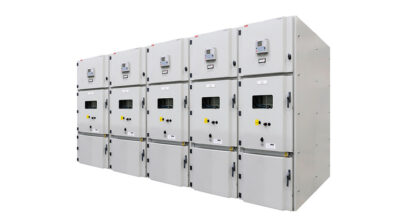Improving power distribution quality through ABB’s energy storage systems
By EPR Magazine Editorial July 26, 2022 6:37 pm IST
By EPR Magazine Editorial July 26, 2022 6:37 pm IST

Uday R. Sampat, Vice President – Marketing & Sales – Distribution Solutions, ABB India in an interview with EPR magazine
When it comes to developing and maintaining efficiency in power systems and power distribution networks, Uday R. Sampat, Vice President – Marketing & Sales – Distribution Solutions, ABB India, says, “ABB’s Battery Energy Storage Systems, which help with load levelling, frequency regulation, power quality improvement, and spinning reserve, can be a key solution to meet this challenge of meeting peak demand.”
What measures are in place to address the surge and maintain an efficient power distribution network?
Electricity is the primary source of power for running machinery, recharging electronic gadgets, and many other tasks in small and large businesses. Electrical burnouts during voltage surges are a common problem for electrical equipment plugged into outlets. Therefore, it is crucial to protect against voltage spikes to avoid long-term harm to equipment.
Reliable, clean, efficient, and uninterrupted power is vital to mission-critical operations. ABB’s power switching and distribution solutions redefine power reliability by providing the highest safety and availability for diverse equipment loads. ABB’s medium voltage power distribution switchgear offers reliable and flexible power distribution solutions with required configurations of switchboards to feed motor/transformer/capacitor/lighting loads or otherwise be used for generation purposes in conventional or renewable generations. All the switchgear is equipped to handle any kind of surge in the system through a dedicated surge arrestor installation in the switchgear as per the application. Moreover, the switchboards are tested for the highest internal arc fault rating level. Light-based arc sensors enable faster response against any fault generated in the panels. Other monitoring and diagnostics solutions are available to maintain the assets efficiently to avoid any failures in switchgear.
How are the power generation companies balancing the demand and supply mismatch for the power distribution caused by the increasing urbanisation and modernisation of power infrastructure?
To meet demand, the Indian government is pursuing several reforms and variable generation, such as solar and wind. This was followed by the launch of green electricity, allowing renewable electricity to be traded at a premium for buyers looking to fulfil their renewable purchase obligations (RPOs).
ABB is partnering with various solar and wind developers to support electricity evacuation infrastructure for renewable projects with their state-of-the-art medium voltage Vacuum Circuit Breakers and Switchgears to support the GOI target of adding 450MW of RE capacity to the grid by 2030. Furthermore, ABB is also contributing its energy-efficient solutions to the complete value chain.

ABB offers multiple digital solutions and upgrades to the power generation companies to upgrade the plant’s electrical infrastructure, making it safer, energy-efficient, and reliable, like centralised protection solutions, Arc Sensor solutions, load-shedding solutions, and fast bus transfer solutions.
Peak consumption time adds excessive load on the transmission lines, further impacting the transmission and distribution. How are the DISCOMs dealing with the same to curtail the intensity of power losses?
The power sector has witnessed tremendous growth over the past five years in generating, transmitting and universal electricity access. The continued progress in inter-state and intra-state transmission networks has removed transmission bottlenecks and created sufficient transmission capacity to transmit electricity generated from one region to another. In the distribution sector, the government of India has been assisting the states/distribution companies (DISCOMs) through various schemes since 2014, namely the Deen Dayal Upadhyaya Gram Jyoti Yojana (DDUGJY); Pradhan Mantri Sahaj Bijli Har Ghar Yojana (SAUBHAGYA); and the Integrated Power Development Scheme (IPDS).
The distribution system has been strengthened under DDUGJY and IPDS in rural and urban areas. However, to further focus on improving DISCOM’s operational efficiencies and financial sustainability, the Revamped Reforms Based and Results-Linked Distribution Sector Scheme (RDSS) has been formulated by the Ministry of Power to support DISCOMs undertaking reforms and improve performance in a time-bound manner. ABB is quite geared up to help this initiative through various Make in India safe and digitally enabled products and solutions. One key solution to meet this challenge of meeting peak demand can be ABB’s Battery Energy Storage Systems, which help with load levelling, frequency regulation, power quality improvement, and spinning reserve.
What are the challenges in integrating renewable energy into the grid for efficient distribution?
To accommodate a higher percentage of renewable energy, the electricity grid would need large quantities of conventional backup power and massive energy storage. It is advantageous and efficient to incorporate renewable energy sources into the grid to generate and transmit power to different centres. As a result, less traditional energy may be used, which benefits the environment and costs, availability, location, and transportation.
The variation in solar energy output during the day and the year is highly predictable because the sun’s movement is very well understood. However, an additional, lesspredictable source of variability in the presence of clouds that can pass over solar power plants and limit generation for short periods. Cloud cover can result in very rapid changes in the output of individual PV systems. Still, the impacts on the electric grid are minimised when solar projects are spread out geographically so that they are not all impacted by clouds simultaneously. In this way, the variability from multiple systems is smoothened. One essential method is optimised storage solutions for aligning solar and wind generation peaks with demand peaks. ABB offers one such solution: their state-of-the-art Battery Energy Storage Systems (BESS). These are single-piece delivery solutions with simple installation, factory assembly, and tested solutions.
What are your thoughts on the burdens faced by urban utilities today?
A smart city is a continuously evolving ecosystem that empowers individuals to live, work, and move in a safer, smarter, and more sustainable way. Thanks to rising incomes and improving living standards, India is the world’s third-largest energy-consuming country. As the world seeks ways to accelerate the pace of transformation in the energy sector, India is uniquely positioned to pioneer a new model for low-carbon, inclusive growth.
The innovations from ABB support aspirations for improved quality of life, safety, efficiency, and sustainability. By leveraging achievements in digital and operational technologies, ABB helps societies to manage the pressures of rapid urbanisation and to meet the growing demand for sustainable, intelligent and reliable energy and water supply, transportation solutions, buildings and industries.
ABB has launched PrimeGear ZX0, the world’s first switchgear that allows users to switch to an eco-efficient insulation gas, which reduces the impact of global warming by 99.99 per cent at any point in its lifecycle. This product was launched under GOI’s prestigious Make in India initiative and would be the most suited product for sustainable distribution applications
We use cookies to personalize your experience. By continuing to visit this website you agree to our Terms & Conditions, Privacy Policy and Cookie Policy.